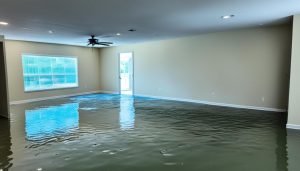Did you know that nearly 70% of homes in the United States have mold? This fact shows how common mold is, making it important for homeowners to know how to remove it. Mold is a fungus that grows in damp, warm places. It can be spotted by its musty smell or green, black, or white spots. You’ll often find it in bathrooms, kitchens, and basements.
Health risks from mold spores include breathing problems and allergies. So, it’s key to deal with mold quickly. For mold solutions, stores like The Home Depot have safety gear and cleaning products. Taking action fast is important for your health and your home’s safety.
This article will cover the best ways to get rid of mold at home. We’ll talk about understanding mold problems and how to remove it effectively.
Key Takeaways
- Effective mold removal is crucial since nearly 70% of U.S. homes have mold.
- Mold grows in damp, warm spots and is often found in bathrooms, kitchens, and basements.
- Spotting mold early with its musty smell and visible spots can lessen health risks.
- Mold spores can cause breathing problems and allergies, so removing it quickly is important.
Understanding Mold and Its Health Risks
Mold is common in many homes. Knowing about types of indoor mold helps prevent health issues. Molds like Cladosporium, Aspergillus, and Stachybotrys, also known as black mold, can grow on many surfaces. These molds are usually harmless to healthy people but can be dangerous for those with weak immune systems.
The respiratory risks from mold exposure are a big concern. Breathing in mold spores can cause allergies, make asthma worse, and even lead to infections. This is especially true for allergens from molds like Penicillium and Alternaria.
Mold is everywhere, inside and outside, and many people breathe it in every day. While it’s usually not a problem, being around a lot of mold spores can cause long-term breathing problems. So, it’s important to know about the types of indoor mold and their mold health implications to keep our homes healthy.
Safety Precautions Before Mold Removal
Before starting any mold cleanup, making sure you follow mold removal safety steps is crucial. It’s important to wear the right personal protective equipment for mold cleaning. This includes N-95 respirators, long gloves, and goggles without holes for ventilation. These items protect you from breathing in mold spores or getting them in your eyes, which can lead to allergic reactions.
Experts suggest these key cleaning safety tips:
- Avoid touching mold directly – Use gloves that cover your wrists.
- Wear goggles without ventilation holes – They keep mold spores out of your eyes.
- Put on an N-95 respirator – It shields you from breathing in mold spores.
- Never mix certain chemicals – Some blends, like bleach and ammonia, can create harmful fumes.
Following these cleaning safety tips helps keep you safe and ensures a successful mold removal safety process.
Chemical or Natural Mold Cleaners
Getting rid of mold at home can be done with different methods. You can choose from natural mold remedies or commercial mold removal products. Each has its own pros and cons.
If you like natural mold remedies, you might find white vinegar and baking soda helpful. These DIY mold cleaners are good for the planet and won’t break the bank. Just spray vinegar on the mold, wait an hour, and then clean it off.
Commercial mold removal products offer a stronger solution. They include professional-grade fungicides for tough mold problems. Make sure to follow the instructions carefully to be safe and effective.
Chemicals like bleach and ammonia are common for cleaning mold. But never mix them because they can create harmful fumes. Apply the solution directly to the mold and let it sit. Always wear gloves and make sure the area is well-ventilated.
Choosing between DIY mold cleaners and commercial mold removal products is important. The best way to get rid of mold is to pick the right product and use it correctly.
Step-by-Step Guide to Mold Removal
The process of getting rid of mold has specific steps for different surfaces. This guide will show you how to clean mold from various surfaces in your home effectively.
- Identify Affected Areas: Start by checking your home for mold. Look in basements, bathrooms, and near windows.
- Prepare the Tools and Materials: Collect your gear like gloves, masks, brushes, and cleaners. You can use chemicals or go for eco-friendly options like vinegar or baking soda.
- Non-Porous Surfaces: For surfaces like tiles and countertops, just scrub with a cleaner. Make sure to clean well to get rid of all mold.
- Porous Materials: For things like drywall and insulation, be gentle. Clean the surface carefully to avoid spreading mold. If it’s badly damaged, you might need to replace it.
- Wood Surfaces: Wood might need sanding to get rid of mold. After sanding, clean the area again with a mold cleaner to remove all spores.
- Exterior Mold: For mold on the outside, like siding, use bleach. Scrub gently, then rinse well to remove bleach residue.
- Dry the Area: After removing mold, dry the area well. Use dehumidifiers or fans to help dry it faster and stop mold from coming back.
By following these steps, you can efficiently remove mold from your home. Using these DIY methods lets you tackle mold on different surfaces with confidence and accuracy.
How to Prevent Mold Growth in Your Home
Stopping mold from growing is key to a healthy home. Keeping humidity between 30-50% is important for humidity control for mold prevention. Use exhaust fans in bathrooms and kitchens, and make sure your home gets good airflow.
Cleaning and looking after your home are crucial steps. Experts say regular care is a must. Clean areas that get wet often, like basements and bathrooms.
Moisture meters are great for keeping an eye on humidity. Make sure gutters and downspouts are clear to stop water from gathering near your home. Fixing leaks fast is also key. Good insulation helps keep humidity in check too.
- Maintain humidity levels between 30-50%
- Utilize exhaust fans and ensure good ventilation
- Regularly clean moisture-prone areas
- Use moisture meters to monitor humidity
- Ensure gutters and downspouts are clear
- Fix leaks promptly
- Maintain proper insulation
By following these steps, you can manage moisture and humidity well. This helps prevent mold from growing in your home.
Conclusion
Keeping your home mold-free requires a mix of quick fixes and long-term plans. By learning about mold and its health risks, you can make smart choices about getting rid of it. It’s crucial to follow safety steps to protect yourself and your home.
Choosing between chemical and natural cleaners is a big decision. Each has its own benefits. A detailed guide helps you tackle mold removal right, using the right cleaners safely and effectively.
Stopping mold from coming back is just as important. Use things like humidity control, regular cleaning, and good airflow to lower the chances of mold coming back. With advice from experts, you can keep your home healthy and mold-free.
This summary shows the need for quick actions and lasting solutions. It highlights the importance of being proactive and informed. By doing so, you can keep your home safe, clean, and free from mold.








